Food photography lighting is of course “just” like any other kind of photographic lighting; all about the masterful control of highlights and shadows; angle and direction; quality and quantity of light. Many of the lighting techniques used in portrait, advertising, or still-life photography, for example, can be usefully adapted to the production of food photography too.
Still, every so often, certain trends in food photography lighting emerge and take on a distinct life of their own. Some of these no doubt follow wider lighting trends that are popular in photography more generally. Others are more unique to the field of food photography itself.
Food Photography Lighting Styles To Inspire
Read on to check out some of the freshest food photography lighting trends to have grabbed our attention in recent months.
#1 Hard Flash
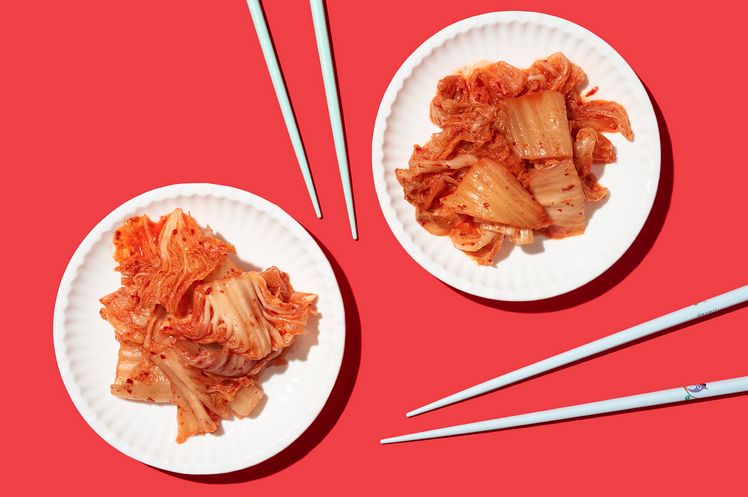
Hard flash food photography lighting by Davide Luciano
There’s nothing like the hard electric slap of studio-strobes to add an edgy, in-your-face vibe to a photo. Aggressive, graphic and unpretentious, the light from a single unadorned flash-head probably puts you more on-trend than any other style of lighting at the moment. For extra nowness, couple it with a nice solid color-block backdrop in a juicy bubblegum tone. As NY-based photographer Davide Luciano did for the fantastic graphic shot of kimchi above.
Lighting styles come and go of course, and the bare-bulb look was a big part of the ’90s grunge aesthetic. As seen in gritty, lo-fi fashion shoots by the likes of Juergen Teller or Corinne Day. Given that all the hip-kids are channeling Kurt Cobain’s early ’90s style-book right now, this might partly explain the return to popularity of the technique. In actual fact though, the look never really went away, and can be seen in mid-Noughties American Apparel ads, Vice Magazine covers and plenty of facile present-day blog-fodder.
Really though, inspiration for the current hard-flash food photography lighting trend lies much further back: in kitsch ’70s product shots. So perhaps the resurgence can be traced to contemporary photographic artist Lucas Blalock?
Hero of recent photo-school graduates everywhere, Blalock’s garish, hard-spanked, graphic images of frankfurters and watermelons mangled by Photoshop-failure clearly take their lead from the commercial photography of the 1970s. Meanwhile his quirky visual humor lends itself well to the Instagram age: helping to spread far and wide the influence of this particular lighting style (not to mention hot-dog sausages).
Pro tip: if the naked strobe dish isn’t giving you sufficiently hard-edged shadows, add a honeycomb-grid modifier.
#2 Natural Daylight
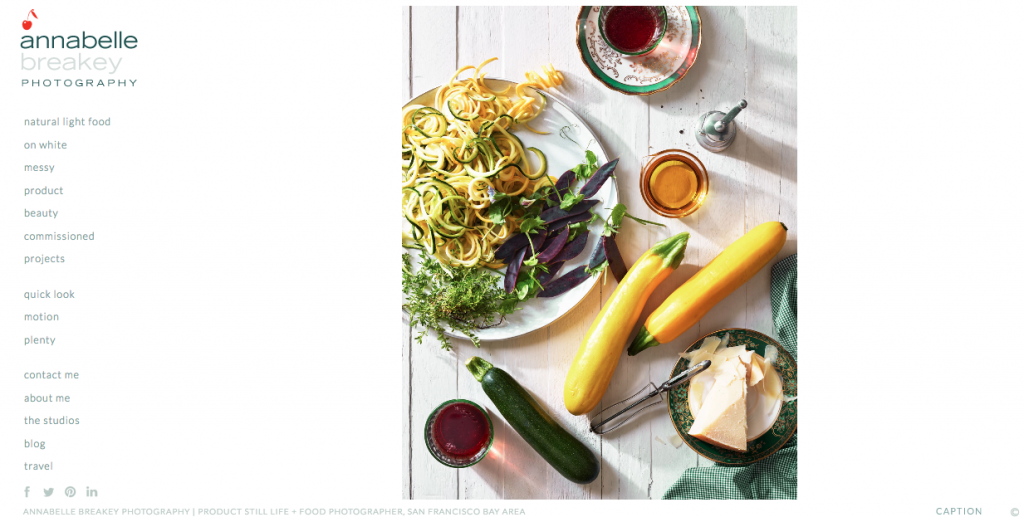
Bay Area photographer Annabelle Breakey excels in natural-light food photography
Clearly the sun never goes out of style. But what we’ve picked up on of late is a tendency to combine the use of fresh, cool daylight with a certain kind of folksy, take-me-as-you-find me approach to food styling. Think French farmhouse kitchen with the windows flung open on a spring day, allowing long beams of sunlight to pick out the rustic charms of some simply prepared country-fare on a rough-hewn wooden table.
This is no doubt yet another manifestation of our growing awareness as a civilization that the economic efficiency of industrialized production (be it of food or otherwise) is invariably accompanied by a corresponding shit-dive in quality. From craft beers to hand-pulled-anything, this is an age characterized by an almost morbid nostalgia for the simpler – and by extension, more wholesome – ways and methods of yesteryear.
And to be perfectly honest, there’s not a lot to argue with here. Indeed, natural simplicity is frequently the best path.
This can be the case with photographic lighting too, and the creative use of simple, raw daylight will often produce truly beautiful images. Breakey’s shot of zucchini uses the daylight-look to great effect: long shadows (suggesting a small, low window as the primary light source) casting the fresh produce scattered across the table into pleasing relief.
The key here is learning to control natural light as best we can, while at the same time accepting that nature ultimately does as it pleases. As in other areas of life, we’ll need to play by nature’s rules if we want to get anywhere.
Take note, though, that the apparently casual arrangement of dishes that tends to accompany this type of lighting is nonetheless a question of top-notch styling, not just happy accident. The above shot is as carefully contrived and executed as any other.
Similarly, although Annabelle Breakey is famed for her fantastic use of natural light, for all we know the “small window” illuminating the above image might actually have been a well-positioned softbox, and the “French farmhouse” an industrial unit in SF’s Dogpatch district. But that’s the magic of skillful food photography.
Either way, it’s a great look that’s exactly right for the times.
#3 Chiaroscuro
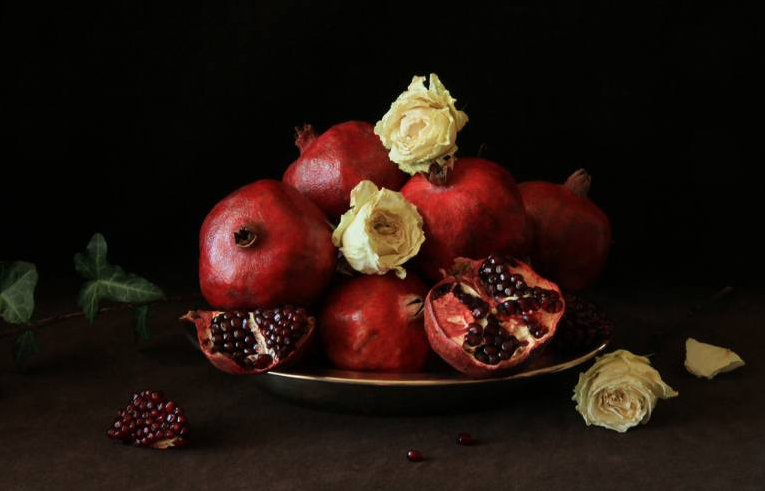
Chiaroscuro food photography from Julia Sent on Pinterest
Chiaruscuro literally means light and dark. It’s a term that was first used to describe the dramatic painting style of Renaissance artists such as Leonardo da Vinci, and later Caravaggio in particular. Caravaggio’s moody portraits, dramatic religious scenes, and decadent still-life paintings were filled with the same demons that ultimately lead the Italian artist to murder one of his contemporaries – allegedly after a row over a game of tennis.
While Caravaggio’s violent, erratic, and often paranoid behavior is not something we’d particularly encourage our readers to emulate, his use of light very definitely is. And in recent years many food photographers have done just that. Please read about some tips and insights form the master of chiaruscuro photography Jon Wild.
This is a clear case of a trend that first began in other areas of photography, before crossing over into food photography: under the influence of artists such as Philip Lorca diCorcia and Gregory Crewdson, dark and dramatic lighting styles have been growing in popularity throughout the world of photography since at least the late ’90s.
However, Caravaggio’s rich baroque still-life paintings of fruit make for particularly ripe (excuse the pun) inspiration with regards to food photography lighting. New York artist Julia Sent‘s image of pomegranates above being a particularly fine example.
#4 Electric Sunshine
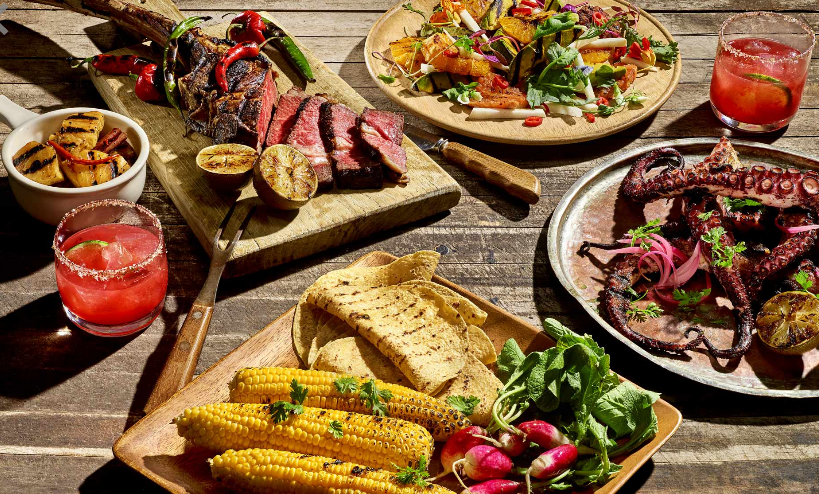
Sam Kaplan is a versatile advertising and commercial photographer based in NYC. Here he makes excellent use of the instant-sunshine strobe look for a Mexican-themed spread.
With a revival of ’80s poolside vibes and the return of the Hawaiian shirt, there’s plenty of demand for shots of tropical fruit and summer cocktails right now. This usually means going for deeply saturated colors under the searing rays of the sun.
Unfortunately, though, the sun can’t always be relied upon to deliver. But if a shot calls for bright summer sun, then bright summer sun it shall have: albeit with a little help from Profoto if necessary (disclosure: we have no affiliation with Profoto whatsoever, they just happen to make truly great quality lights).
From a technical point of view, this falls about halfway between the look of the naked strobe and natural daylight styles we looked at above: often softer, warmer and a little more natural-feeling than the light of a bare flash head; yet always much harsher and higher in contrast than the spring-daylight look.
Under this lighting everything sizzles and sweats like a Brit sunbather in a Martin Parr photo. So it’s a technique that’s perfect for creating the atmosphere of a midsummer picnic or beach barbecue, or adding a touch of tropical heat to a setup. Even when shooting in a chilly Chicago studio complex on a gloomy February morning.
#5 Edible Neon
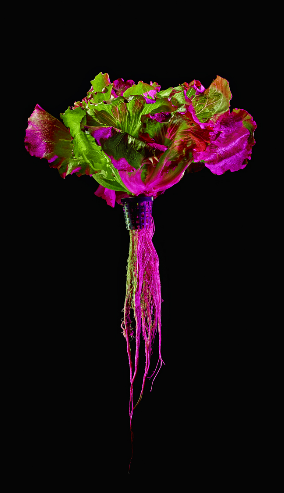
Another great example of creative lighting food photography from Sam Kaplan
Once again, this is a style that appears to have recently begun to spill over from trends in other genres of photography, such as fashion and music. Both of which have displayed new found interest in past lighting techniques in recent years. Indeed, there’s a distinctly retro vibe to this look: seemingly straight from the cover of a mid ’70s Bryan Ferry LP (his lost classic, “Disco Lettuce”, perhaps?).
It’s a fun and distinctive technique that is certainly eye-catching, and Kaplan makes stylish use of it in the above shot. Although superficially quite easy to achieve – just stick a few colored gels on your studio lights and away you go – of all the food photography lighting styles we’ve looked at here it’s almost certainly the most difficult to do well. Play around with this one by all means, but when it comes to lighting it’s worth remembering that a little color often goes a long way.
It remains to be seen, however, just how much demand for the neon vibe there will be in the long term. In fact, call us old-fashioned, but food photography is, ultimately, about food. And let’s be honest, the unnatural colors most commonly seen in this style of lighting tend not to be ones that anyone in their right mind would want anywhere near their plate.
Each to their own.
Anywhere, if you were looking for food photography lighting inspiration, hopefully this article has provided you with ample food for thought.
Perhaps even thought for food?
Let us know how you get on with your own food photography lighting experiments in the comments below!


Lazy Beefcake
Thanks for this. Really interesting and thought provoking article. Will def be having a play around with some fo these lighting ideas when I next get a chanve. More of this please!